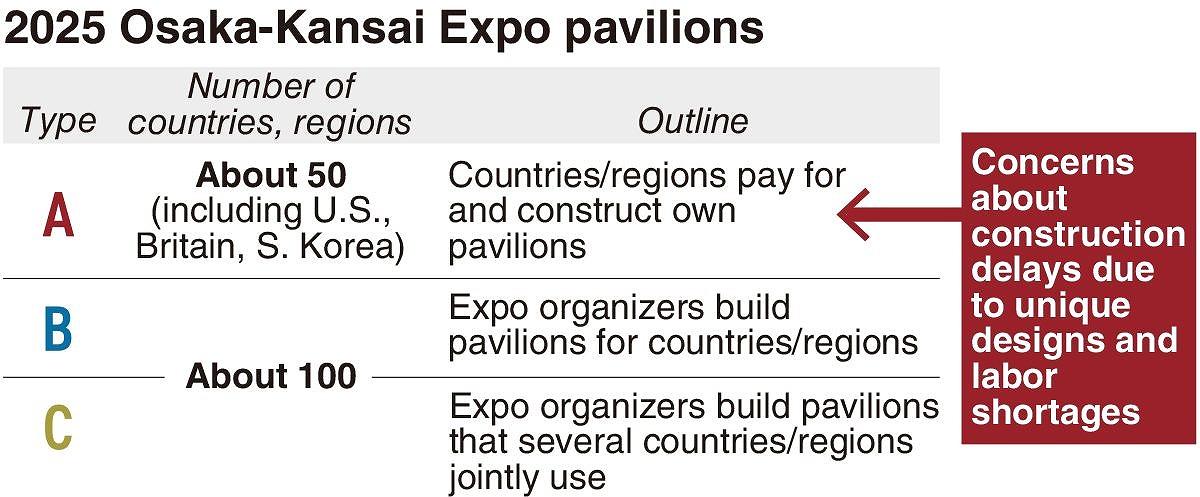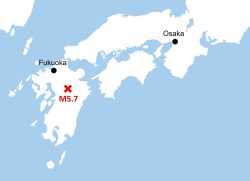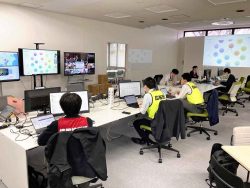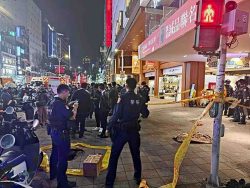
6:00 JST, July 15, 2023
Key preparations for the 2025 Osaka-Kansai Expo are on thin ice because a labor shortage and soaring prices of building materials are causing delays in the construction of national pavilions.
With participating countries and regions struggling to contract builders, among other issues, the government and event organizer, the Japan Association for the 2025 World Exposition, are scrambling to find ways to get preparations back on track. However, it remains to be seen whether the situation can be resolved in time.
The association’s secretary general, Hiroyuki Ishige, indicated Thursday that the organizers are determined to assist expo participants who are grappling with delays. “We’ll provide support across the board to ensure everything is ready in time for the expo’,” Ishige said at a press conference.
A total of 153 countries and regions have announced plans to participate in the 2025 expo, which will be held from April 13 and Oct. 13 on the manmade island of Yumeshima in Konohana Ward, Osaka.
About 50 participants, including the United States and Britain, will construct their own pavilions for the event. These self-built structures are categorized as Type A pavilions, while pavilions built by Japan fall under either Type B or Type C.
The self-built pavilions are expected to cost between several hundred million yen and several billion yen.
Participants constructing pavilions have to apply for a building permit from the Osaka municipal government. As of Thursday, however, the city had not received a single application for a Type A pavilion.
It takes about 2½ months from the time an application is lodged until approval is granted and construction work can begin. If a participant were to apply now, construction of the pavilion likely would start around October.
The association believes that unless construction gets underway before the end of this year, the pavilions might not be completed before the curtain goes up on the expo, which is expected to attract about 28.2 million visitors and have an economic impact of about ¥2 trillion.
Permit applications have reportedly been submitted for eight of the 25 Japanese pavilions that feature the involvement of the central government, Osaka prefectural government, Osaka city government and local companies.
Some of the participants planning to build their own pavilions are feeling increasingly anxious about the slow pace of progress. “It really is a major headache,” an official from one country told The Yomiuri Shimbun.
The official said the pavilion design had been completed, but more than 10 building firms had refused to take on the job.
According to the Construction Research Institute, the construction material price index for general construction in the Osaka region stood at 100 in 2015 and increased to an average of 105 in 2018 — the year Osaka was chosen to host the expo. As of June this year, the figure had soared to 137.6, representing an increase of about 30% in just five years.
Labor costs also have been climbing. As a result, the average construction cost per square meter for a pavilion has more than doubled since budgets for such projects were drawn up three years ago.
The weak yen should have eased the financial burden being shouldered by participants, but rising costs have gobbled up those potential gains. Increasing construction budgets might help participants find building contractors willing to sign on the dotted line, but applying for additional funds in their countries or regions take time. Consequently, some participants concerned about not having a pavilion ready in time are considering redoing or scaling down designs.
***
Elaborate designs
With building costs continuing to rise, it is likely to become more difficult to find contractors to take on projects under initial budget plans. In addition, many of the Type A pavilion projects involve elaborate designs, which tend to involve difficult wok.
On top of potential language barriers, negotiations in the event of unforeseen problems or situations not covered by the contract could be difficult, so contractors have reportedly been reluctant to take on projects.
Compounding this is a problem expected to emerge in April 2024, when tougher restrictions on overtime in the construction industry come into force under the revised Labor Standards Law. Some contractors are concerned that it will be more difficult to source workers when the changes kick in.
General contractors voiced their concerns about this situation to the government and expo organizers last year, but solutions have been elusive.
In late June, the government called on the construction sector to accept expo building projects but received a cool response. “We’re involved in other projects aside from the expo, and we don’t have enough workers,” a major contractor said. “It’s already too late to be coming to us with requests.”
On July 7, the expo’s organizing association proposed securing contractors and taking over the construction of some Type A pavilions, with simpler designs to shorten the construction period. However, some participants are reluctant because of the possible impact on national prestige.
The association asked for a response by the end of August. It plans to listen to their suggestions and figure out a way to move forward.
“Designing future society for our lives” is the theme of the expo.
Ishige, the association’s secretary general, remained upbeat at a press conference Thursday. “We’ll do what we can to ensure each participant has a pavilion they will be happy with,” Ishige said.
"Society" POPULAR ARTICLE
-

M4.9 Earthquake Hits Tokyo, Neighboring Prefectures
-

M7.5 Earthquake Hits Northern Japan; Tsunami Waves Observed in Hokkaido, Aomori and Iwate Prefectures
-

Tsukiji Market Urges Tourists to Avoid Visiting in Year-End
-

Israeli Tourists Refused Accommodation at Hotel in Japan’s Nagano Pref., Prompting Protest by Israeli Embassy and Probe by Prefecture
-

M5.7 Earthquake Hits Japan’s Kumamoto Pref., Measuring Upper 5 Intensity, No Tsunami Expected
JN ACCESS RANKING
-

Keidanren Chairman Yoshinobu Tsutsui Visits Kashiwazaki-Kariwa Nuclear Power Plant; Inspects New Emergency Safety System
-

Imports of Rare Earths from China Facing Delays, May Be Caused by Deterioration of Japan-China Relations
-

University of Tokyo Professor Discusses Japanese Economic Security in Interview Ahead of Forum
-

Japan Pulls out of Vietnam Nuclear Project, Complicating Hanoi’s Power Plans
-

Govt Aims to Expand NISA Program Lineup, Abolish Age Restriction






















